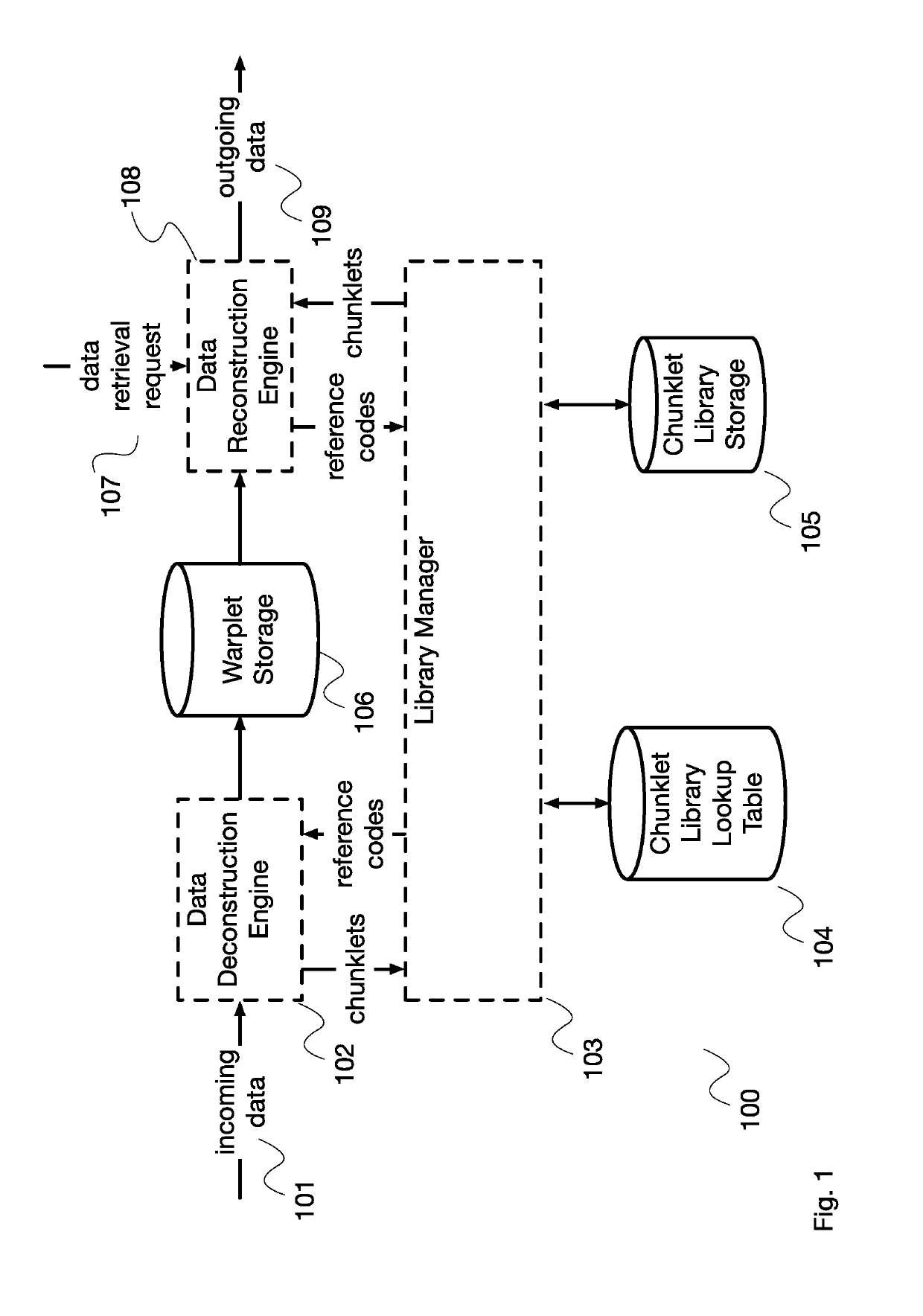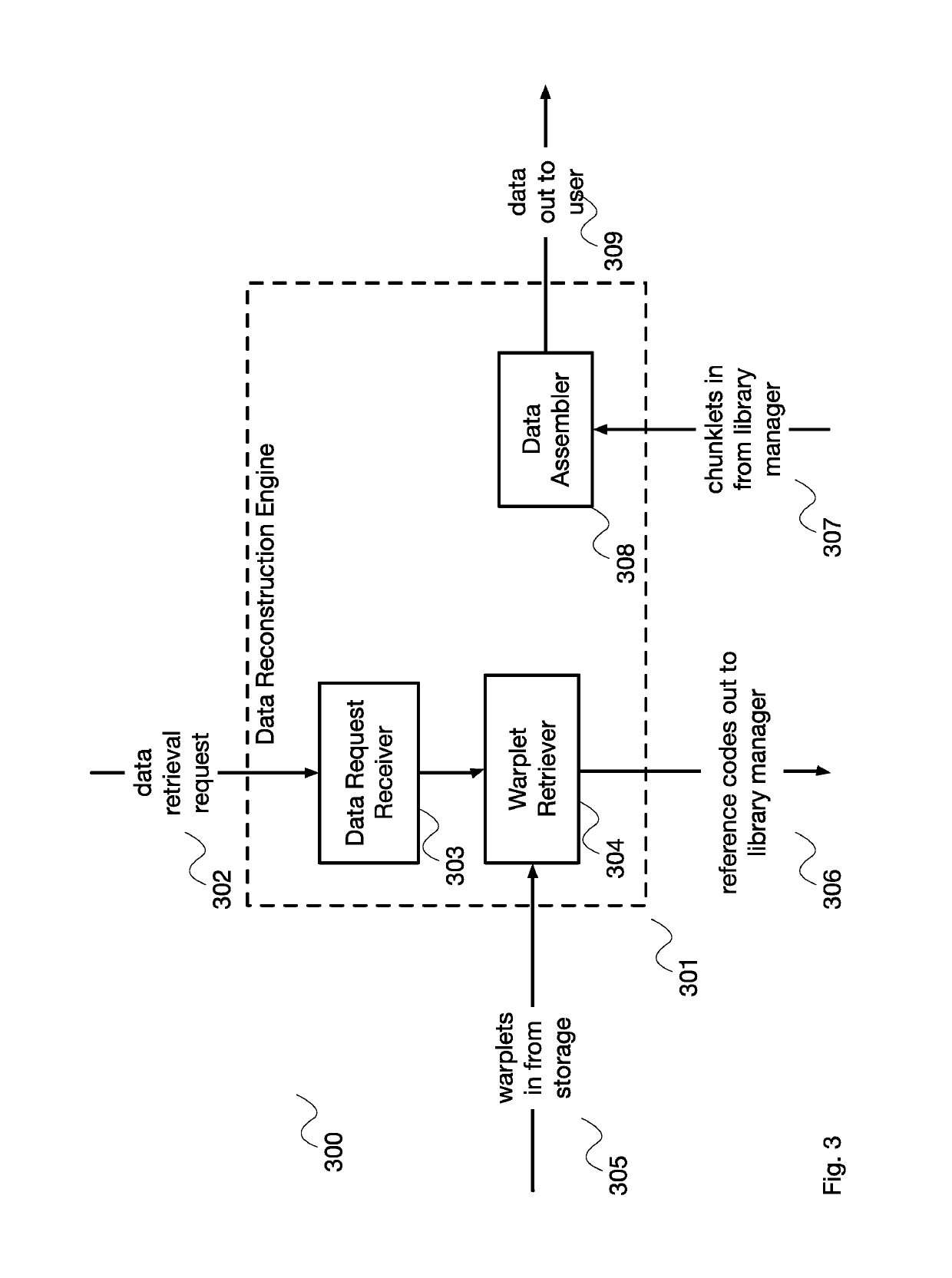System and method for data storage, transfer, synchronization, and security
a data storage and data technology, applied in the field of computer data storage and transmission, can solve the problems of limiting the number of computers, the inability to solve the problem of adding physical storage, and the inability to compress data, so as to achieve the effect of reducing the size of the library, reducing the rate of i/o transfer, and dramatically reducing the space used to store data locally on the system
- Summary
- Abstract
- Description
- Claims
- Application Information
AI Technical Summary
Benefits of technology
Problems solved by technology
Method used
Image
Examples
embodiment 100
[0051]FIG. 1 is a diagram showing an embodiment 100 of the system in which all components of the system are operated locally. As incoming data 101 is received by data deconstruction engine 102. Data deconstruction engine 102 breaks the incoming data into chunklets, which are then sent to library manager 103. Using the information contained in chunklet library lookup table 104 and chunklet library storage 105, library manager 103 returns reference codes to data deconstruction engine 102 for processing into warplets, which are stored in warplet storage 106. When a data retrieval request 107 is received, data reconstruction engine 108 obtains the warplets associated with the data from warplet storage 106, and sends them to library manager 103. Library manager 103 returns the appropriate chunklets to data reconstruction engine 108, which assembles them into the proper order and sends out the data in its original form 109.
[0052]FIG. 2 is a diagram showing an embodiment of one aspect 200 ...
embodiment 600
[0056]FIG. 6 is a diagram showing an embodiment 600 in which a standardized version of a chunklet library 603 and associated algorithms 604 would be encoded as firmware 602 on a dedicated processing chip 601 included as part of the hardware of a plurality of devices 600. Contained on dedicated chip 601 would be a firmware area 602, on which would be stored a copy of a standardized chunklet library 603 and deconstruction / reconstruction algorithms 604 for processing the data. Processor 605 would have both inputs 606 and outputs 607 to other hardware on the device 600. Processor 605 would store incoming data for processing on on-chip memory 608, process the data using standardized chunklet library 603 and deconstruction / reconstruction algorithms 604, and send the processed data to other hardware on device 600. Using this embodiment, the encoding and decoding of data would be handled by dedicated chip 601, keeping the burden of data processing off device's 600 primary processors. Any de...
embodiment 700
[0066]FIG. 7 is a diagram showing an example of how data might be converted into reference codes using an aspect of an embodiment 700. As data is received 701, it is read by the processor in chunklets of a size dynamically determined by the previously disclosed chunklet size optimizer 410. In this example, each chunklet is 16 bits in length, and the library 702 initially contains three chunklets with reference codes 00, 01, and 10. The entry for reference code 11 is initially empty. As each 16 bit chunklet is received, it is compared with the library. If that chunklet is already contained in the library, it is assigned the corresponding reference code. So, for example, as the first line of data (0000 0011 0000 0000) is received, it is assigned the reference code (01) associated with that chunklet in the library. If that chunklet is not already contained in the library, as is the case with the third line of data (0000 1111 0000 0000) received in the example, that chunklet is added to...
PUM
 Login to View More
Login to View More Abstract
Description
Claims
Application Information
 Login to View More
Login to View More - R&D
- Intellectual Property
- Life Sciences
- Materials
- Tech Scout
- Unparalleled Data Quality
- Higher Quality Content
- 60% Fewer Hallucinations
Browse by: Latest US Patents, China's latest patents, Technical Efficacy Thesaurus, Application Domain, Technology Topic, Popular Technical Reports.
© 2025 PatSnap. All rights reserved.Legal|Privacy policy|Modern Slavery Act Transparency Statement|Sitemap|About US| Contact US: help@patsnap.com



